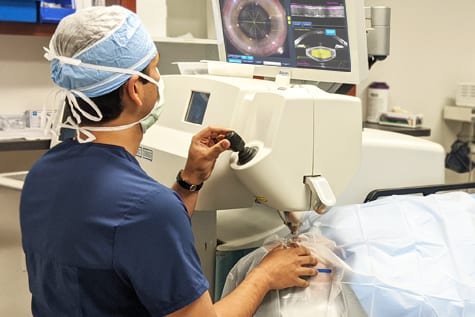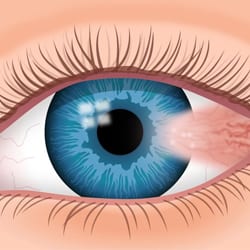Dr. Neel Desai explains a new, innovative technique for pterygium surgery
 Dr. Desai published an article in the medical journal “Ocular Surgery News” regarding a new “tissue tuck” technique he developed for pterygium surgery. Pterygium surgery is used to remove the white mass (pterygium) that can develop on the sclera (white of the eye) that eventually grows into the cornea causing blurry vision and permanent disfigurement.
Dr. Desai published an article in the medical journal “Ocular Surgery News” regarding a new “tissue tuck” technique he developed for pterygium surgery. Pterygium surgery is used to remove the white mass (pterygium) that can develop on the sclera (white of the eye) that eventually grows into the cornea causing blurry vision and permanent disfigurement.
This new technique was developed to overcome the drawbacks of the autograft method of pterygium surgery. In the autograph method, the surgeon places a small portion of the patient’s conjunctiva (mucous membrane covering the front of the eye and the inside of the eyelids) into the area where the surgery is to be performed and absorbable sutures or tissue adhesive is used to seal the wounds. The disadvantages of this technique include relocating parts of the patient’s conjunctiva and creating two surgical wounds causing additional inflammation, scarring, discomfort, and recovery time for patients.
Tissue Tuck Technique
This procedure developed by Dr. Desai, known as the tissue tuck technique, has four key goals:
- Minimize surgical trauma
- Diminish inflammation after surgery
- Better seal the gap from which the pterygium and any recurrence will originate
- Reconstruct the fold to prevent future issues including pyogenic granulomas (red skin growths), scar tissue, muscle restriction, blurry vision, and pterygium recurrence.
Because this technique is sutureless, it saves time and eliminates a potential source of inflammation. Patients report little or no discomfort after surgery and do well with only a topical steroid and an antibiotic. Ultimately, the tissue tuck technique minimizes complications and recurrence of pterygium, reduces surgical time, and better restores vision and the eye’s cosmetic look.
 What is Pterygium
What is Pterygium
A pterygium is an elevated, wedged-shaped bump on the eyeball that starts on the white of the eye (sclera) and can invade the cornea. Because on being in the sunlight for long hours without proper UV protection increases your risk of developing pterygium, this disorder is commonly known as “surfer’s eye.” However, you don’t have to be a surfer or ever see the ocean to get it. Although pterygia are benign (non-cancerous) growths, they can permanently disfigure the eye and can cause discomfort and blurry vision.
For more information on tissue tuck technique, read the full article here: https://www.healio.com/news/ophthalmology/20200629/tissue-tuck-technique-provides-alternative-method-of-pterygium-removal
Meet Your Cornea, Cataract & Refractive Specialist
 Neel Desai, M.D. is a fellowship-trained, board-certified, ophthalmologist strictly specializing in LASIK, cataract and corneal diseases of the eye. Dr. Desai is a top graduate of the Pennsylvania State University College of Medicine and completed his fellowship in cornea, cataract and refractive surgery at the Wilmer Eye Institute at Johns Hopkins University. He is recognized throughout the country and internationally as one of only 100 surgeons able to perform advanced corneal transplants and another complex cataract, corneal and refractive procedures. He holds pending patents to new surgical products and advanced cornea surgical procedures of his own design. Additionally, Dr. Desai has authored many book chapters in his field of study and continues to write articles in peer review journals.
Neel Desai, M.D. is a fellowship-trained, board-certified, ophthalmologist strictly specializing in LASIK, cataract and corneal diseases of the eye. Dr. Desai is a top graduate of the Pennsylvania State University College of Medicine and completed his fellowship in cornea, cataract and refractive surgery at the Wilmer Eye Institute at Johns Hopkins University. He is recognized throughout the country and internationally as one of only 100 surgeons able to perform advanced corneal transplants and another complex cataract, corneal and refractive procedures. He holds pending patents to new surgical products and advanced cornea surgical procedures of his own design. Additionally, Dr. Desai has authored many book chapters in his field of study and continues to write articles in peer review journals.

